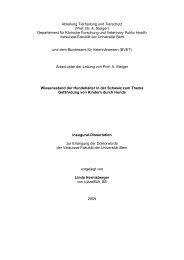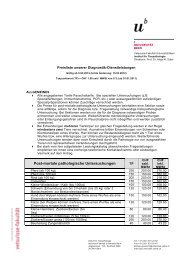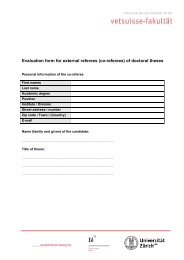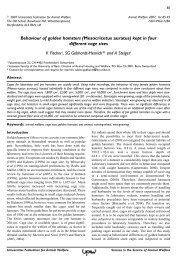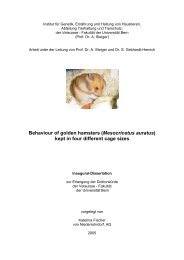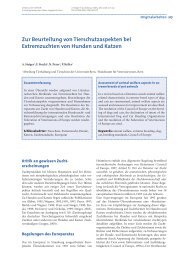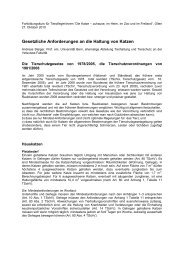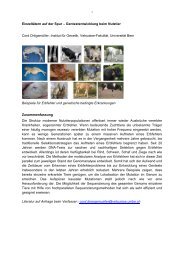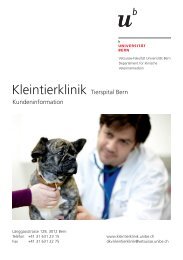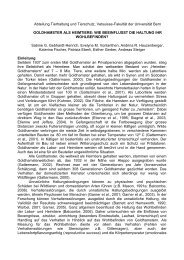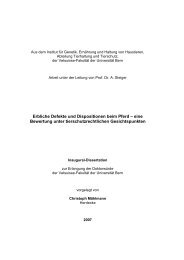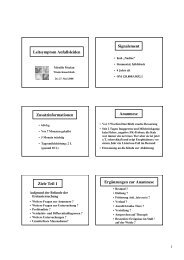Lifespan and Causes of Death in the Irish Wolfhound - Vetsuisse ...
Lifespan and Causes of Death in the Irish Wolfhound - Vetsuisse ...
Lifespan and Causes of Death in the Irish Wolfhound - Vetsuisse ...
Create successful ePaper yourself
Turn your PDF publications into a flip-book with our unique Google optimized e-Paper software.
mitochondrial hyperplasia, disruption <strong>of</strong> my<strong>of</strong>ibrils <strong>and</strong> Z b<strong>and</strong> thicken<strong>in</strong>g. All <strong>of</strong> <strong>the</strong>se<br />
features (except Z b<strong>and</strong> thicken<strong>in</strong>g) can also be found <strong>in</strong> <strong>the</strong> heart muscle <strong>of</strong> cl<strong>in</strong>ically<br />
healthy dogs, although to a much smaller degree. Mitochondrial hyperplasia <strong>and</strong><br />
disruption <strong>of</strong> my<strong>of</strong>ibrils were described as hav<strong>in</strong>g a similar extent <strong>in</strong> 46 sections from<br />
eight DCM cases <strong>in</strong> giant dogs. These f<strong>in</strong>d<strong>in</strong>gs are not specific for DCM, however,<br />
but ra<strong>the</strong>r reflect long st<strong>and</strong><strong>in</strong>g ventricular hypertrophy with subsequent congestive<br />
heart failure (Bishop 1986).<br />
A more recent study found that giant breed DCM is characterised by th<strong>in</strong> attenuated<br />
wavy myocardial fibres as opposed to <strong>the</strong> “fatty <strong>in</strong>filtration degenerative” type seen <strong>in</strong><br />
Doberman P<strong>in</strong>schers <strong>and</strong> Boxers (Tidholm <strong>and</strong> Jonsson 2005).<br />
Additionally, some animals seem to exhibit high-grade panarteriitis <strong>of</strong> <strong>the</strong> larger<br />
cardiac arteries, especially <strong>in</strong> <strong>the</strong> left ventricular wall <strong>and</strong> <strong>the</strong> <strong>in</strong>terventricular septum,<br />
lead<strong>in</strong>g to particular obstruction <strong>of</strong> <strong>the</strong> lumen (Broschk 2004).<br />
3.3.1.2 Symptoms<br />
In <strong>Wolfhound</strong>s, DCM goes through a long subcl<strong>in</strong>ical stage that is ma<strong>in</strong>ly<br />
characterised by atrial fibrillation (AF) as mentioned above. Contrary to “lone atrial<br />
fibrillation” <strong>in</strong> humans, this seems to be an objective risk factor for <strong>the</strong> eventual<br />
development <strong>of</strong> DCM to <strong>the</strong> po<strong>in</strong>t that it can be said that <strong>Wolfhound</strong>s with AF can be<br />
considered to likely be <strong>in</strong> a stage <strong>of</strong> “occult DCM” (Koch, Pedersen et al. 1996;<br />
Vollmar 1996; Brownlie <strong>and</strong> Cobb 1999).<br />
Weight loss, comb<strong>in</strong>ed with extreme tachycardia, dyspnoea <strong>and</strong> ascites are reported<br />
to be <strong>the</strong> typical symptoms <strong>of</strong> cl<strong>in</strong>ically manifest <strong>Wolfhound</strong> DCM. These <strong>and</strong> o<strong>the</strong>r<br />
signs <strong>of</strong> progressive cardiac failure, such as exercise <strong>in</strong>tolerance, cough<strong>in</strong>g <strong>and</strong><br />
general apathy are usually <strong>in</strong>dicative <strong>of</strong> an advanced stage <strong>of</strong> <strong>the</strong> disease (Brownlie<br />
<strong>and</strong> Cobb 1999).<br />
3.3.1.3 Diagnosis<br />
While fully developed cl<strong>in</strong>ical DCM is comparably easy to diagnose, it is important for<br />
optimal treatment to catch <strong>the</strong> disease <strong>in</strong> an early stage. On auscultation, low-pitched<br />
protodiastolic gallop sounds are <strong>in</strong>dicative <strong>of</strong> DCM, as are pulse deficits, absolute<br />
arrhythmia <strong>and</strong> tachyarrhythmia. In about half <strong>of</strong> <strong>the</strong> dogs with DCM, a s<strong>of</strong>t<br />
regurgitant systolic murmur can also be heard (Fox, Sisson et al. 1999).<br />
Electrocardiographically, AF is <strong>the</strong> most consistent ECG sign found <strong>in</strong> <strong>Wolfhound</strong>s<br />
with DCM. O<strong>the</strong>r abnormities may <strong>in</strong>clude ventricular <strong>and</strong> supraventricular premature<br />
contractions (VPC’s <strong>and</strong> SVPC’s), P mitrale <strong>and</strong> 1 st <strong>and</strong> 2 nd degree AV-block.<br />
Bigem<strong>in</strong>al rhythm <strong>and</strong> paroxysmal tachycardia can also be observed. It is also<br />
possible for a <strong>Wolfhound</strong> with DCM to have an entirely normal ECG, although this<br />
must be considered rare (Brownlie 1991; Harpster 1994; Brownlie <strong>and</strong> Cobb 1999;<br />
Vollmar 2000).<br />
Echocardiography is <strong>the</strong> gold st<strong>and</strong>ard for <strong>the</strong> diagnosis <strong>of</strong> can<strong>in</strong>e DCM (Fox, Sisson<br />
et al. 1999). Reference values for healthy <strong>Wolfhound</strong>s <strong>and</strong> exact values for<br />
diagnostic parameters were published <strong>in</strong> 1999 (Vollmar 1999 a; Vollmar 1999 b).<br />
Parameters with highly significant variability between <strong>the</strong> groups <strong>of</strong> normal dogs,<br />
19



